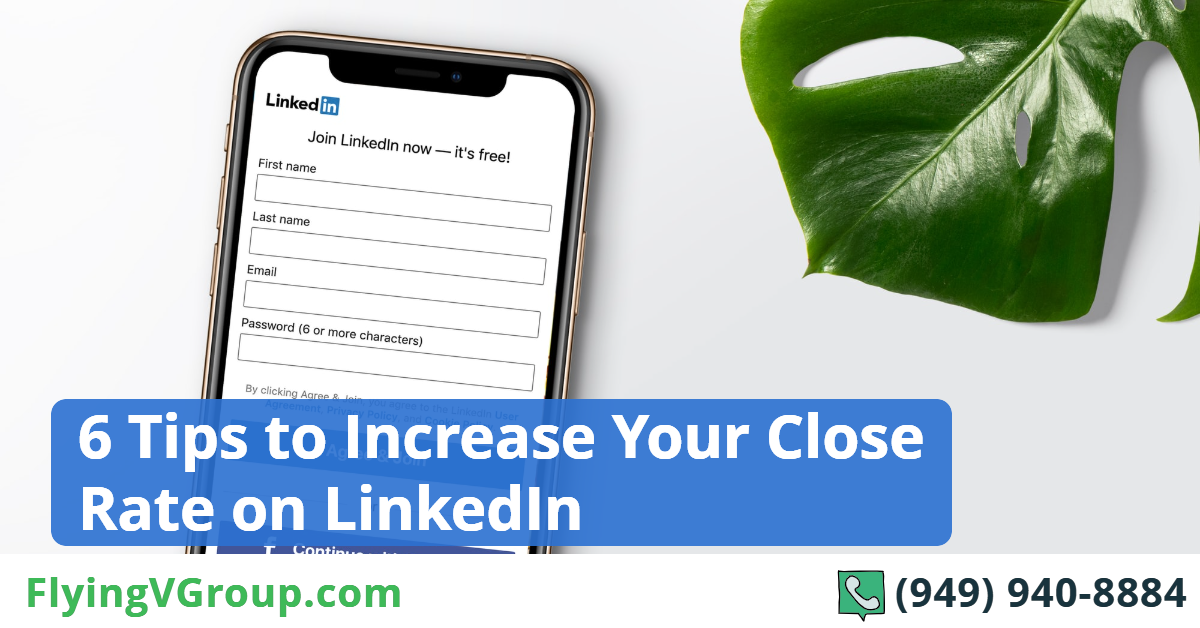LinkedIn is a real gold mine for sales prospecting.
Of the social media site’s 756 million-strong user base, 63 million are decision makers – people with the power to sign off on purchases.
What’s more, the site is responsible for generating an estimated four-fifths of all B2B marketing leaders from social media.
However, just because LinkedIn offers you the potential to get in front of the right prospects, there’s no guarantee that you’ll turn engagements into meaningful conversations and meaningful conversations into leads.
With that in mind, here are six tips to improve your close rate on LinkedIn.
1. Optimize Your LinkedIn Profile
What happens when you get a connection request on LinkedIn from someone you don’t recognize?
Presumably, you click on their profile, try to figure out why they want to connect with you and make a call on whether or not to accept.
That’s exactly what everyone else does, too. So if you’ve barely updated your profile since graduating college, there’s a good chance you’re putting off potential leads.
Fortunately, leveling up your LinkedIn profile isn’t a particularly complex task; it just requires paying attention to the following areas:
Find the Right Keywords
Search engine optimization or SEO isn’t just for websites. Optimizing your LinkedIn profile includes finding the right keywords your target audience uses and strategically placing them throughout your profile, including your headshot, headline, and in the about section to name a few.
Headline
Your LinkedIn headline is the text that appears beneath your name on your profile and next to your name in search, so it’s an extremely important piece of LinkedIn real estate.
Most people enter their exact job title in their headline. But there are two reasons you shouldn’t do that:
- A lot of job titles don’t mean very much to people outside your company or industry
- People are automatically wary of anyone with a “salesy” job title
Instead, try explaining how your product or service helps your customers. For instance, it could be something like: “Helping sales teams turn cold prospects into warm leads.”
Background Image
LinkedIn is first and foremost a professional platform, so your background image should be something that directly relates to your company or industry, or perhaps to your location (particularly if your location is particularly relevant to your potential customers).
Profile Picture
If you don’t have a profile picture, you’re likely missing out on a lot of leads. Indeed, LinkedIn’s own data shows that profiles with a picture are 14 times more likely to be viewed and generate a 40% higher InMail response rate. Always use a professional-looking headshot here.
Summary Text
Along with your profile picture and headline copy, your summary text is one of the few elements of your LinkedIn profile that appears “above the fold” on both desktop and mobile.
Use this important space to briefly discuss your professional background, your interests, and what you do within your organization. Add a call to action for people to connect with you, too.
2. Dig Into Your Prospect’s Profile
Now that you’ve optimized your LinkedIn profile, it’s time to start reaching out to potential leads.
The first step in this process is to find prospects on LinkedIn and research their profiles. The more you can learn at this stage about their role, experience, and objectives, the better informed you’ll be when you (hopefully) strike up a conversation with them down the line.
Beyond carrying out helpful research, there’s a second benefit to exploring a prospect’s profile.
As you know, when you visit someone’s profile, LinkedIn sends that person a notification. That effectively puts you on their radar, meaning your name and face are at least somewhat familiar when you eventually reach out with a connection request.
3. Identify Common Interests & Connections
While you’re in the process of reviewing a prospect’s LinkedIn profile to learn about their professional goals and responsibilities, you should also be on the lookout for any things the two of you have in common. That could include:
- Shared connections
- Shared schools
- Shared former employers
- Shared group memberships
Of those points, the first is potentially the most valuable. In the world of B2B sales and marketing, a recommendation from a trusted peer can go a huge way toward influencing buying decisions. If you can encourage a mutual connection to introduce you to your target prospect, they’re far more likely to accept and listen to what you have to say.
Beyond that, you should also pay attention to the types of content they engage with. If they’ve shared an article you read, or been involved with conversations around topics you follow, that could help you strike up a conversation.
4. Personalize Your Outreach Messages
As a salesperson, you likely send multiple LinkedIn connection requests every day, so it might seem tempting to copy and paste the same introductory message each and every time.
However, that’s unlikely to yield the best results. While it’s perfectly acceptable to utilize a little boilerplate copy, your prospects are more likely to open and respond to your outreach messages if you take the time to personalize them.
Marketers know all about the value of personalization. Indeed, 90% say it makes a significant contribution to the profitability of their business. Not all personalization is created equal, though. One study found that emails incorporating “advanced” personalization – that is, more than just referencing the prospect’s name or company – see a significantly better response rate than those with basic personalization.
5. Keep Your Messages Short & Concise
Your prospects are busy, so make sure you cut straight to the point when you’re reaching out to make your initial introduction.
Rather than speaking at length about how amazing your product is and how many awards you’ve won, hone in on the specific problems they’re likely to be facing. Hopefully, your initial research and past experience will give you a decent steer on likely pain points.
Demonstrate the value you provide, in as few words as possible, by saying something like: “We helped [a similar-sized client in a similar industry] to [overcome a common pain point or hit a common target].”
6. Sign Off With a Question
By this point, you should have crafted an impactful introductory message that sparks interest in your prospects.
The final piece of the puzzle is to compel them to take action. To do this, you need to make it obvious what you want them to do next.
At this early stage of the sales process, it’s likely too soon to ask them to book a demo. Instead, try signing off with a question like:
- How are you tackling [a common pain point] at the moment?
- Why did you [take a specific action, like launching a new product]?
- What is your biggest goal or priority over the next 12 months?
Ultimately, people love talking about themselves. As a sales development rep, you can use this to your advantage by asking meaningful questions to strike up a two-way dialog.
Author – Sujan Patel
Sujan Patel is a partner at Ramp Ventures & co-founder of Mailshake. He has over 15 years of marketing experience and has led the digital marketing strategy for companies like Salesforce, Mint, Intuit, and many other Fortune 500 caliber companies.
SHARE THIS POST
Thank you so much for reading 6 Tips to Increase Your Close Rate on LinkedIn . We really appreciate it! If you have any questions about our article, or can suggest any other topics you think we should explore, feel free to let us know.
Be sure to sign-up for our newsletter to receive monthly emails on all of the latest trends and happenings in the digital marketing space. You will also receive our FREE E-Book with the Amazing Marketing Tools for Powerful Business Growth. Sign-up below!
Also, if you received some value out of this article, please share with your friends or colleagues, or leave a comment/question below. We really appreciate you reading our blog and every share/comment means the world to us and allows us to continue producing valuable tools to help you grow your business!






0 Comments